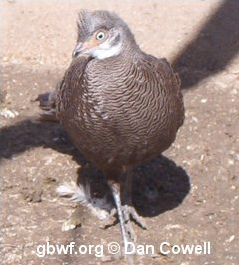 The Grey Pecock-Pheasant, also known as the Chinquis, is the national bird of Myanmar (Burma). There are four subspecies that are found in the tropical forests of south-east Asia. The Himalayan Grey P. b. bakeri is native to Bhutan and western Assam and the Burmese Grey P. b. bicalcaratum, which can be found in eastern Assam, Myanmar (Burma), Thailand and laos, are the two most often kept subspecies. The other subspecies the Ghigi’s Grey P. b. ghigii native to south-eastern China and the Lowe’s Grey P. b. bailyi whose range is not well known, but believed to be native to western Assam.
The Grey Pecock-Pheasant, also known as the Chinquis, is the national bird of Myanmar (Burma). There are four subspecies that are found in the tropical forests of south-east Asia. The Himalayan Grey P. b. bakeri is native to Bhutan and western Assam and the Burmese Grey P. b. bicalcaratum, which can be found in eastern Assam, Myanmar (Burma), Thailand and laos, are the two most often kept subspecies. The other subspecies the Ghigi’s Grey P. b. ghigii native to south-eastern China and the Lowe’s Grey P. b. bailyi whose range is not well known, but believed to be native to western Assam.
Variation in the subspecies is distinct, but it is tough to know which subspecies are currently being reared in American aviaries. bailyi and bakeri are the grayest in overall plumage (bailyi the markings and spots are a darker white or buff; bakeri darker than other, spots pure white), both have been imported and have probably crossed through the years. bicalcaratum is browner than the previous two, has also been reared in captivity; ghigi is similar to bicalcaratum, not as dark and the ocelli always surrounded by buffy gray border. I would to like hear from breeders who have been able to breed true lines.
This species can be distingushed from other Polyplectron species by the overall grayish brown plumage that is finely mottled with drak gray, white and buff. Males have metallic bluish-green ocelli on the wings and mantle. Each tail feather is marked with two large metallic green, with a tint of purple, ocelli. The cheeks and throat are white and he has a gray upright crest that leans forward in courtship displays. The female is much smaller and duller than the male. The ocelli is not near as bright or large as well.
Avicultural Data
These charming little birds do not require very large aviaries, but since they are a tropical species, they do require shelter during the coldest months. Some breeders use heated buildings when the temperatures drop below freezing for several days at a time, and others use dry straw and heat lamps. Being forest birds, be sure to provide plenty of shade during the summer months.
Greys will often become very tame and are not aggressive towards one another. You can breed two hens to one cock. They tend favor more live food than most species of pheasants, and they also enjoy many types of fruits and green food.
The breeding season begins in March and may last until July. The hen will only lay two eggs per clutch, but will lay several clutches if the eggs are collected. The hens also make great mothers and can be allowed to hatch their own eggs. The incubation period lasts about 21 days. Some breeders have difficulty in getting the chicks to start eating, this can be solved by placing a similar sized chick (golden or a bantam) in the brooder to teach the chicks to eat. Placing mealworms or other live “moving” food is another method to get them interested in eating. When the chicks are raised by their natural mother, you will notice that she will offer food to chicks from her beak, so you may want to use a pair of tweezers to offer the mealworms when raising the chicks in a brooder.



